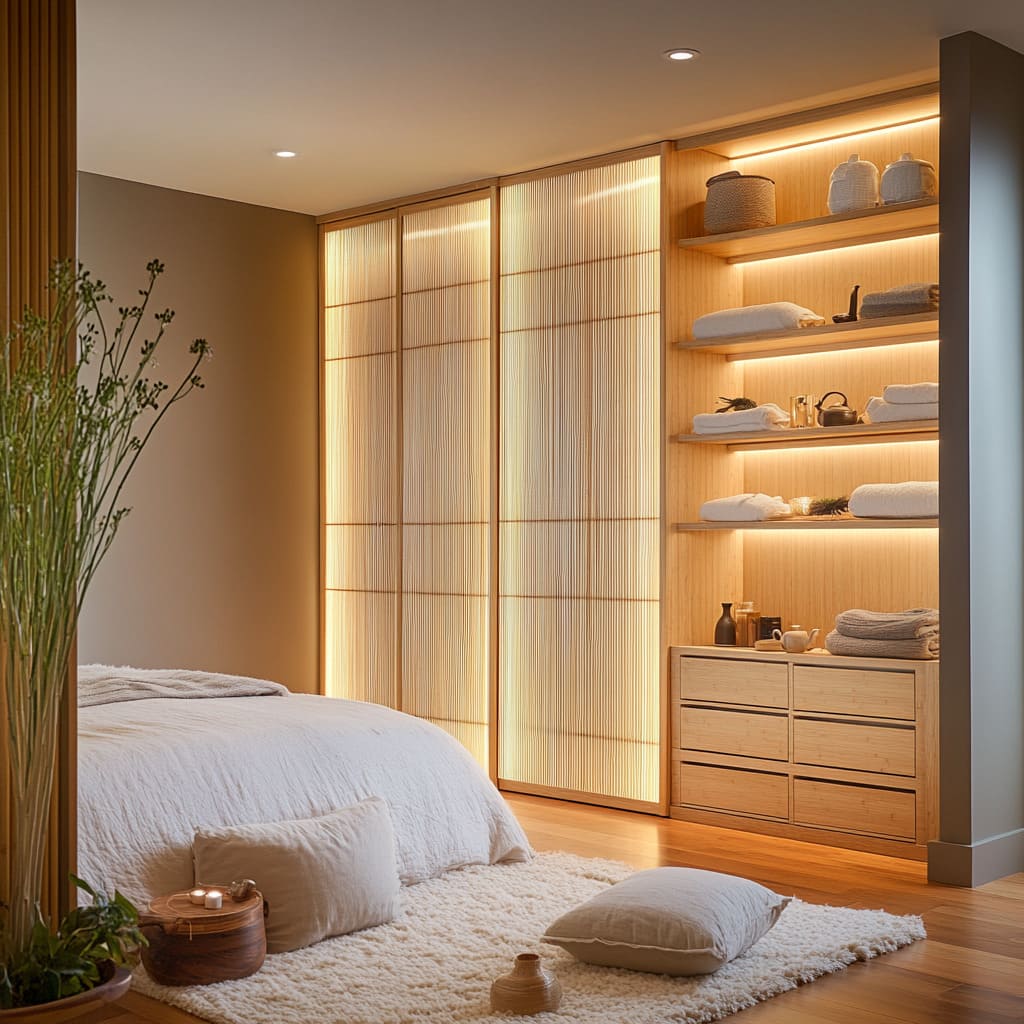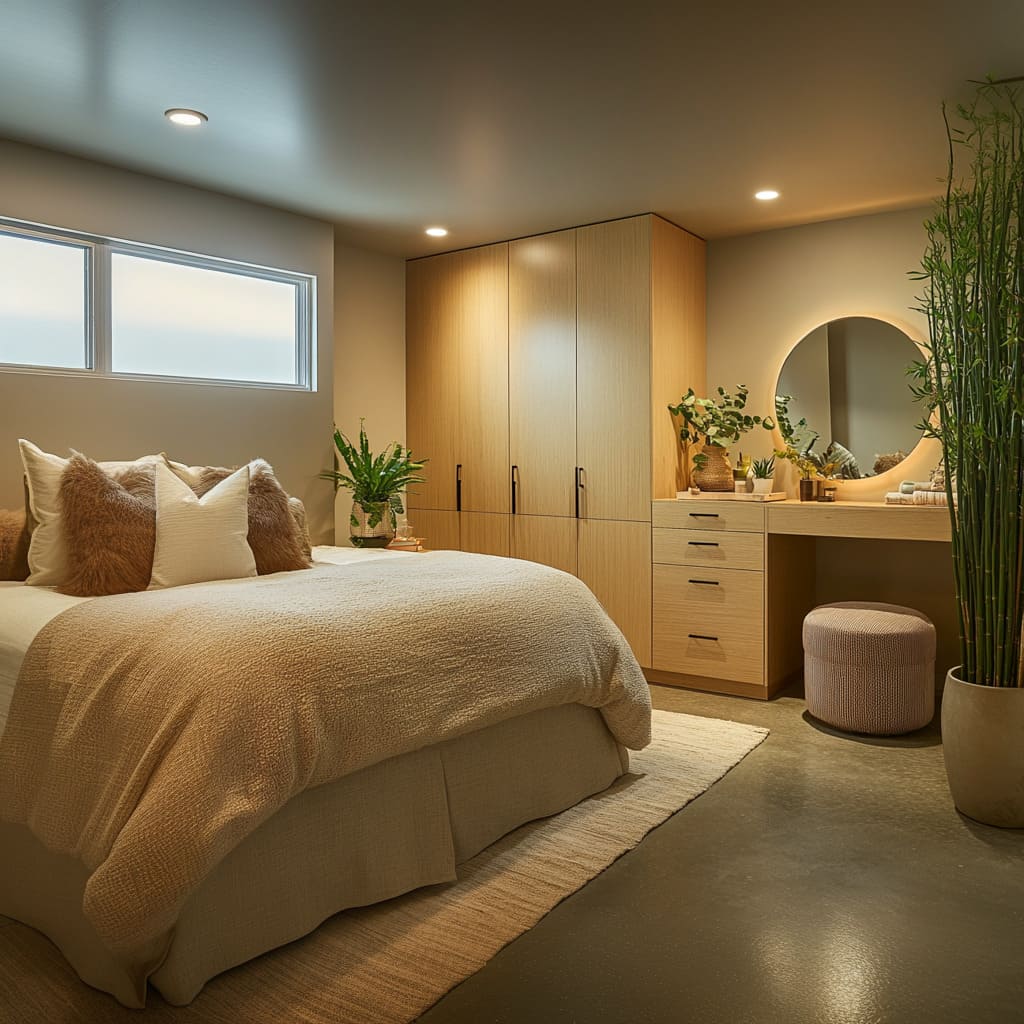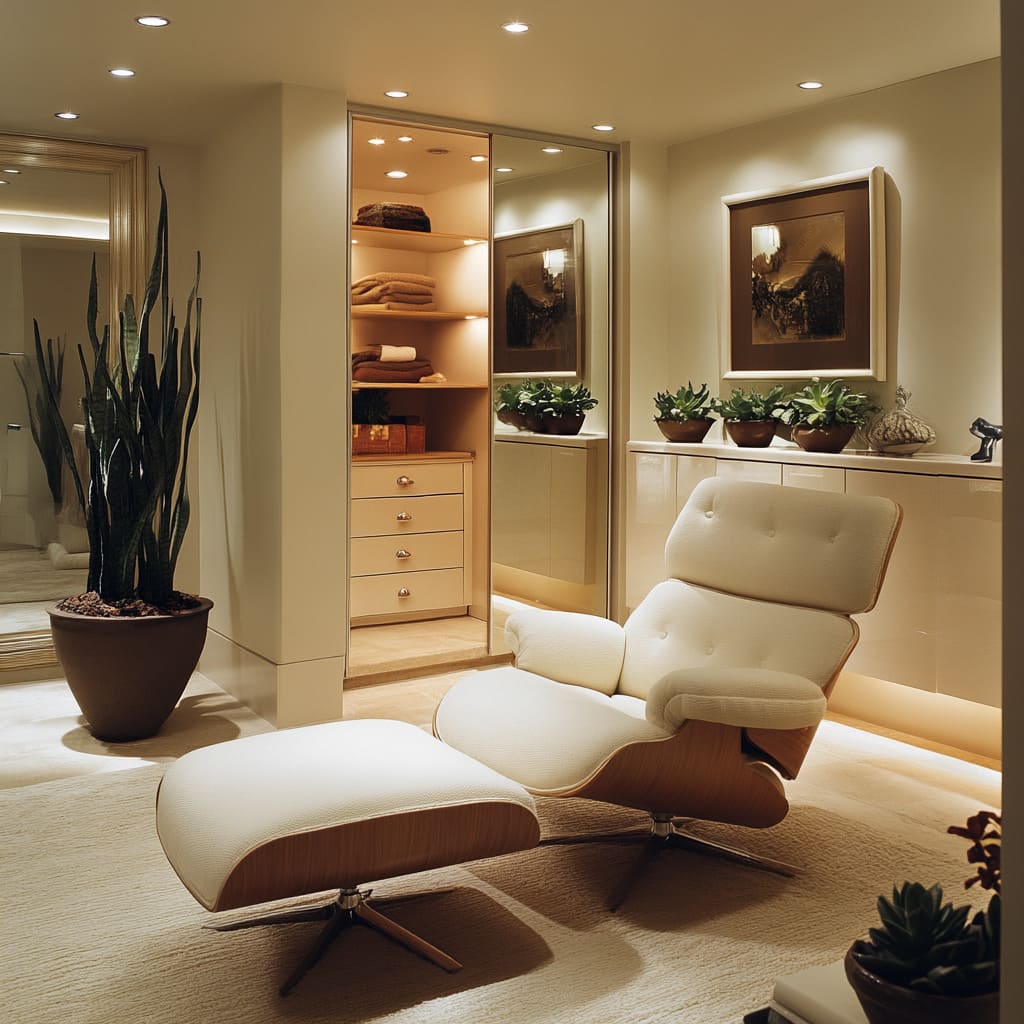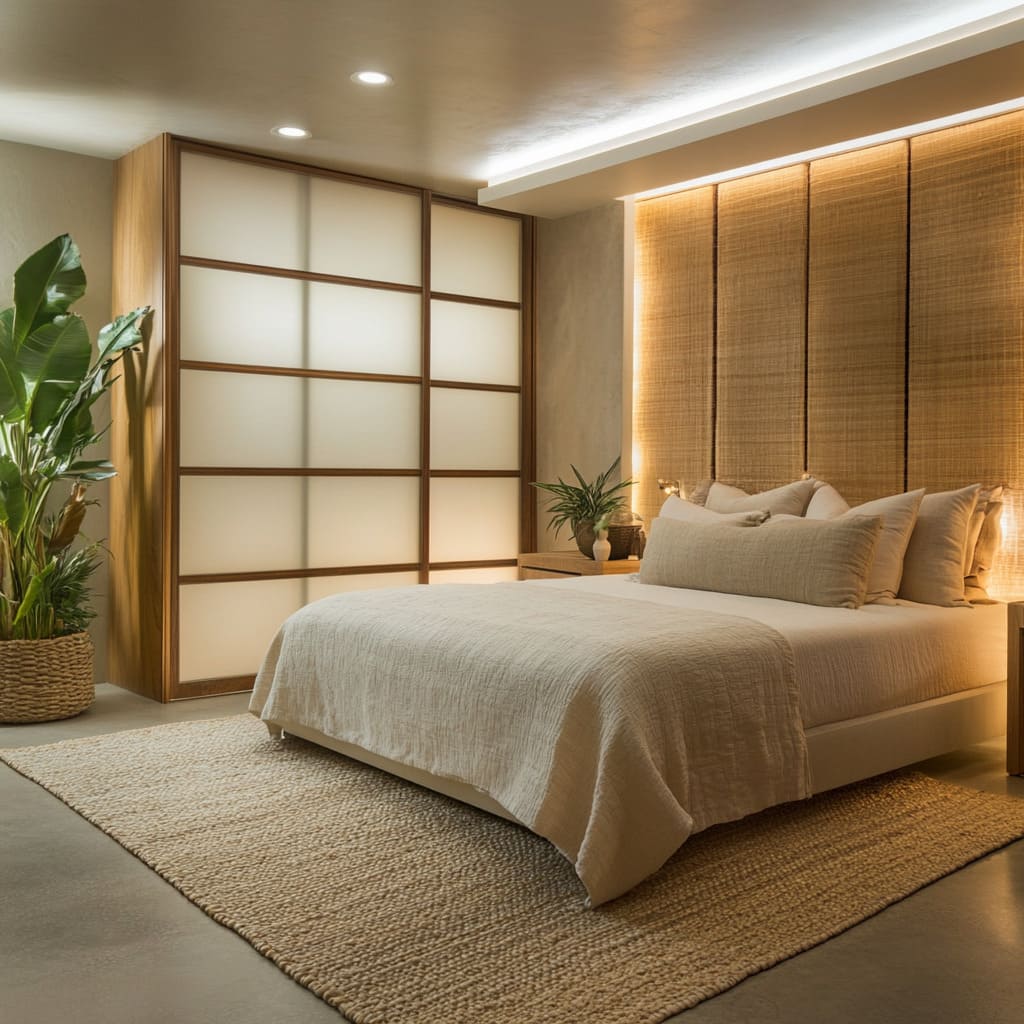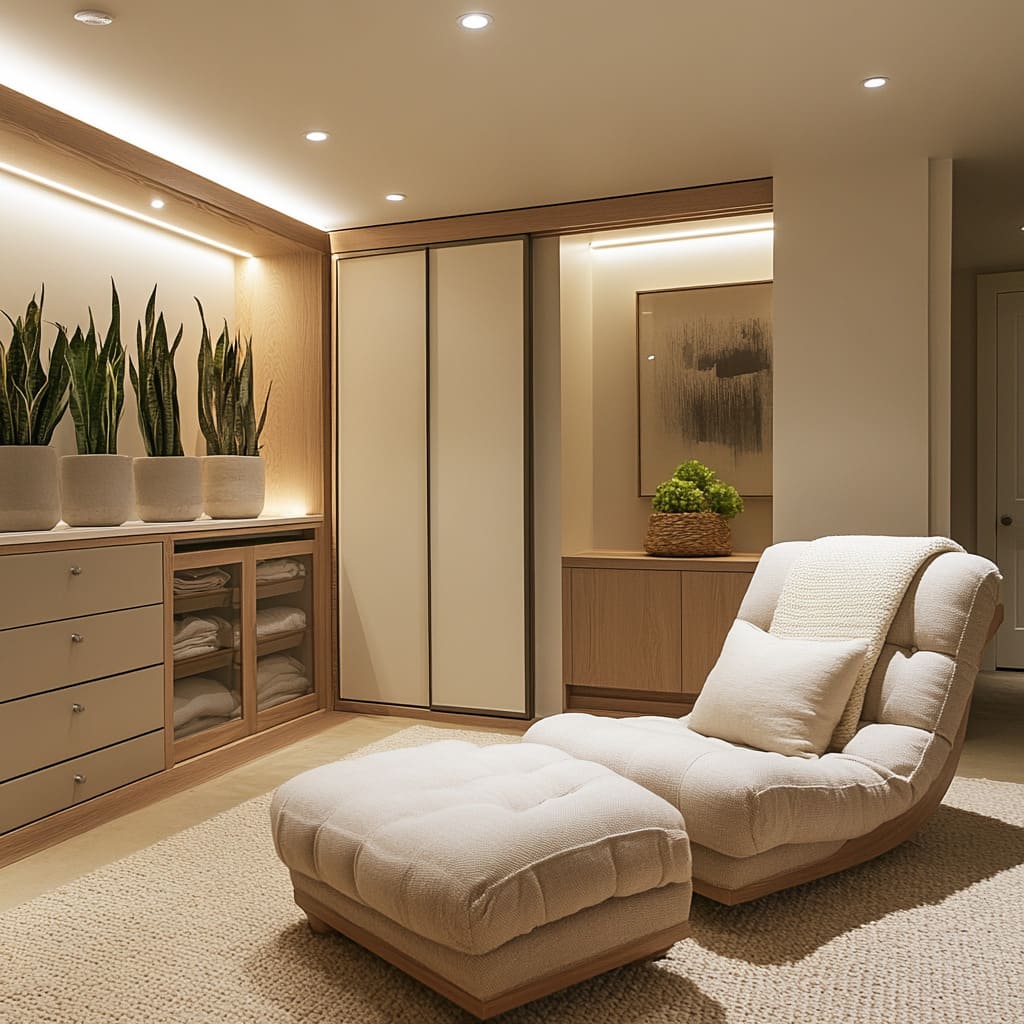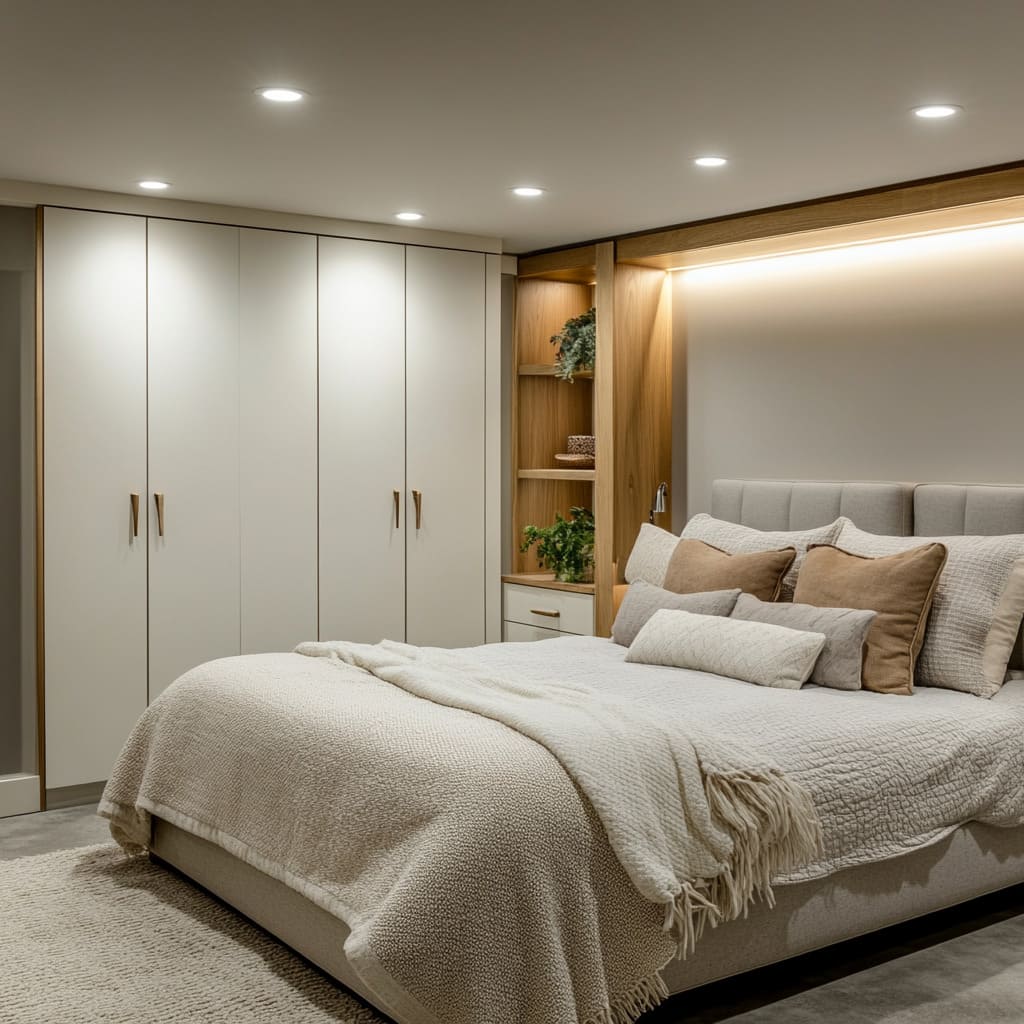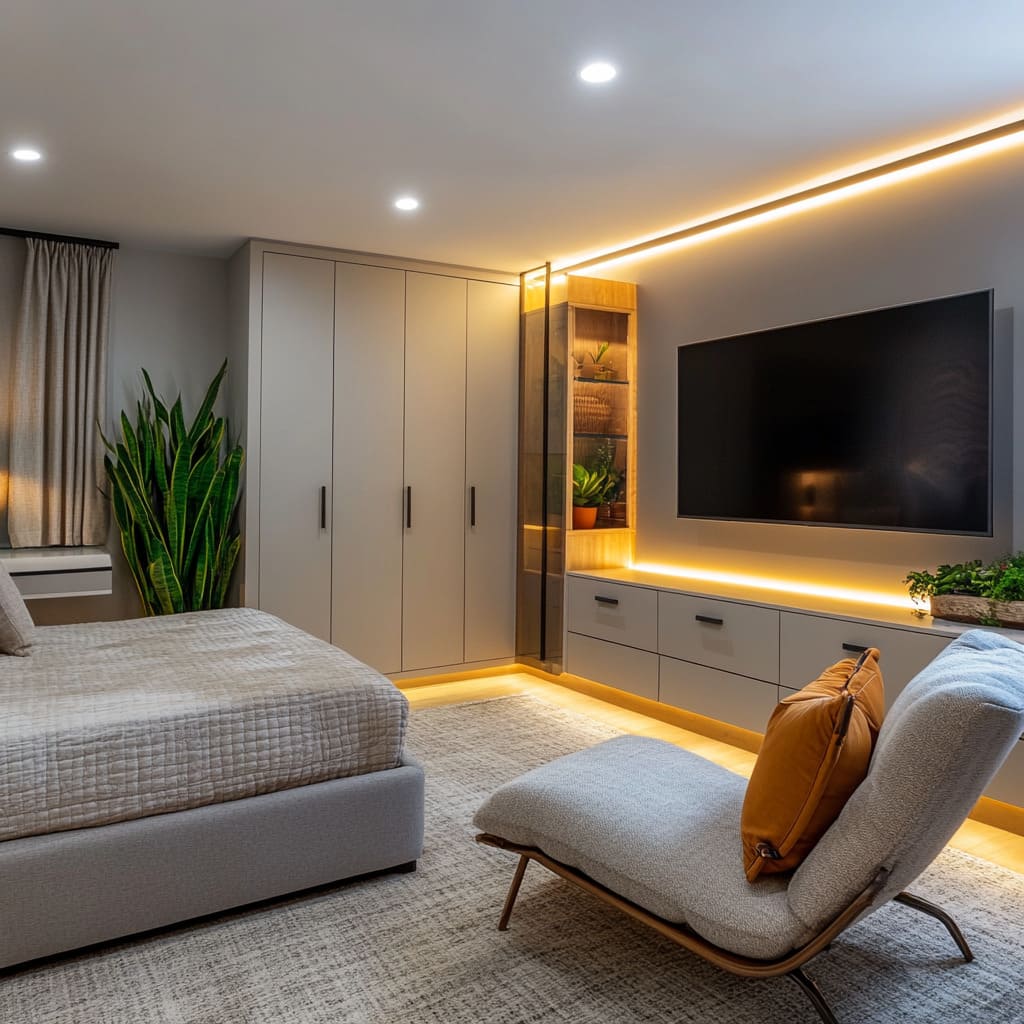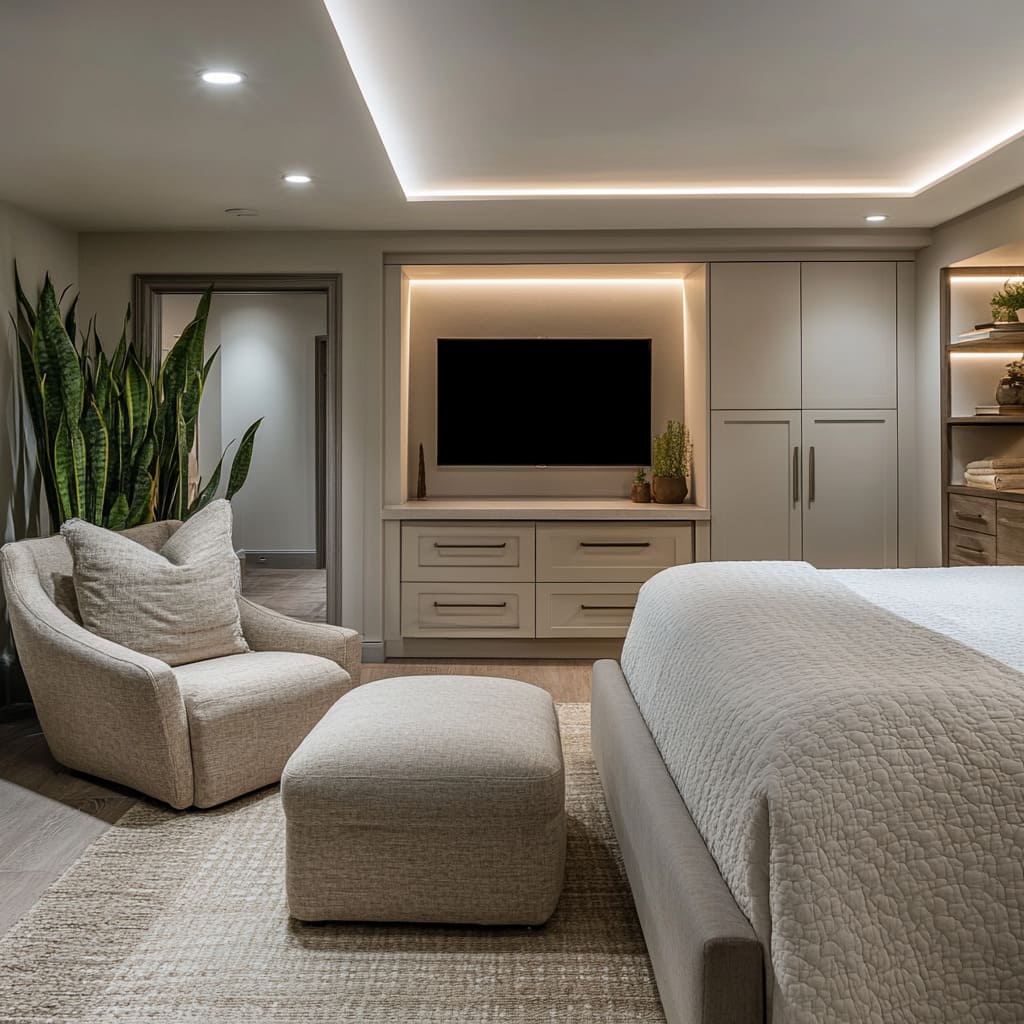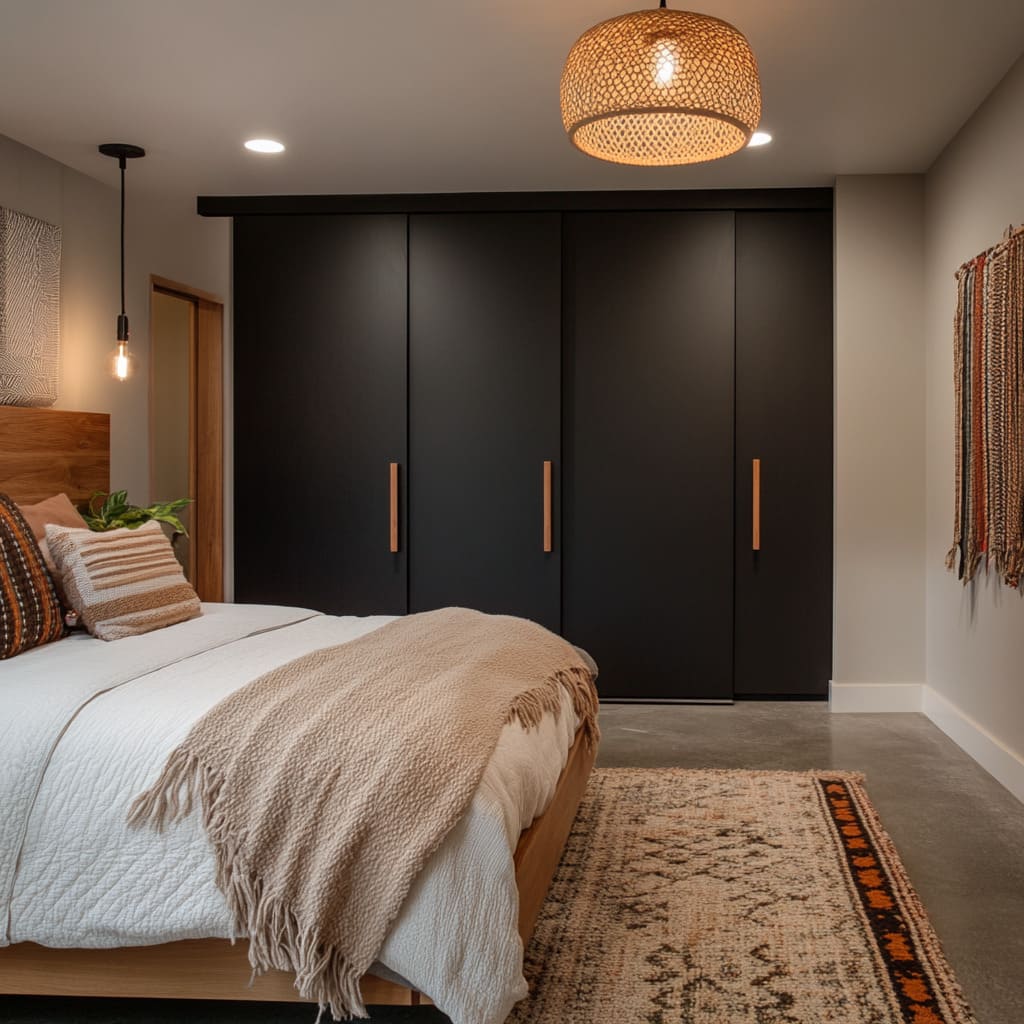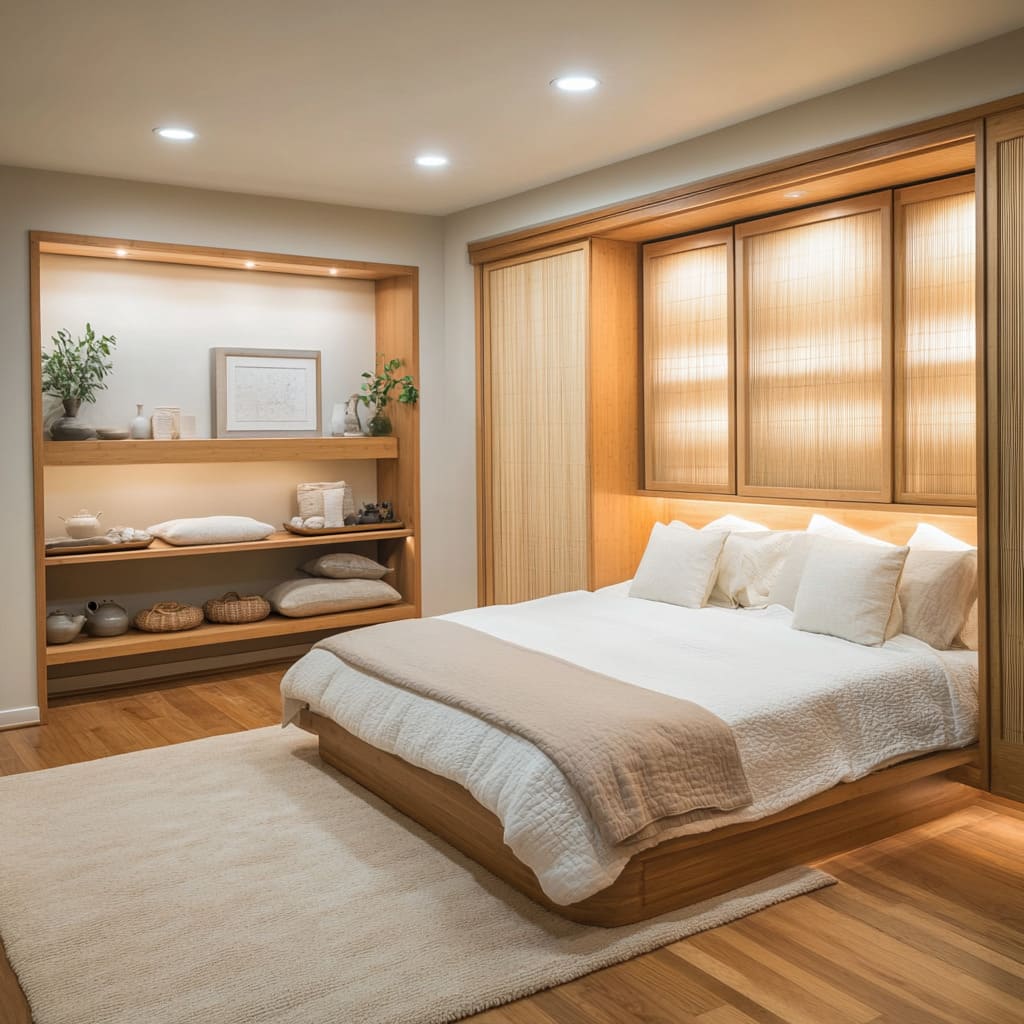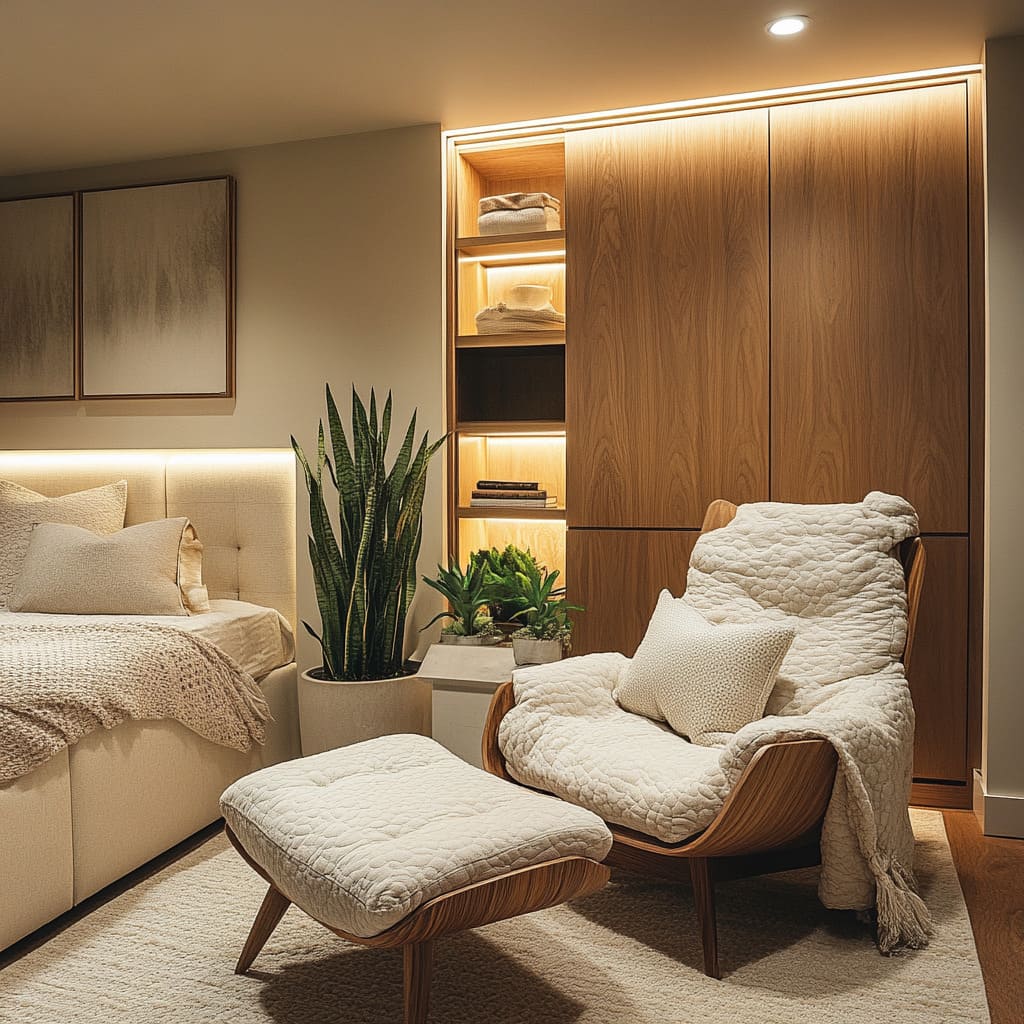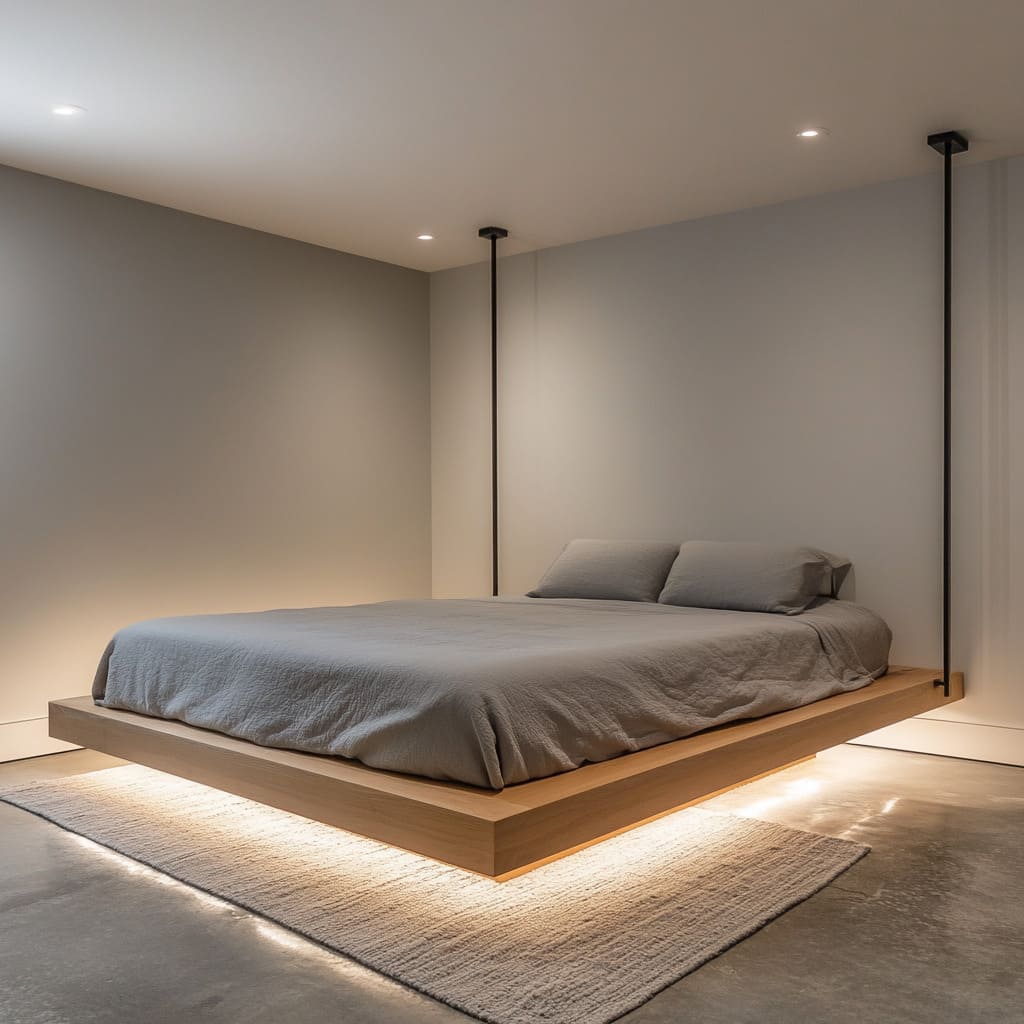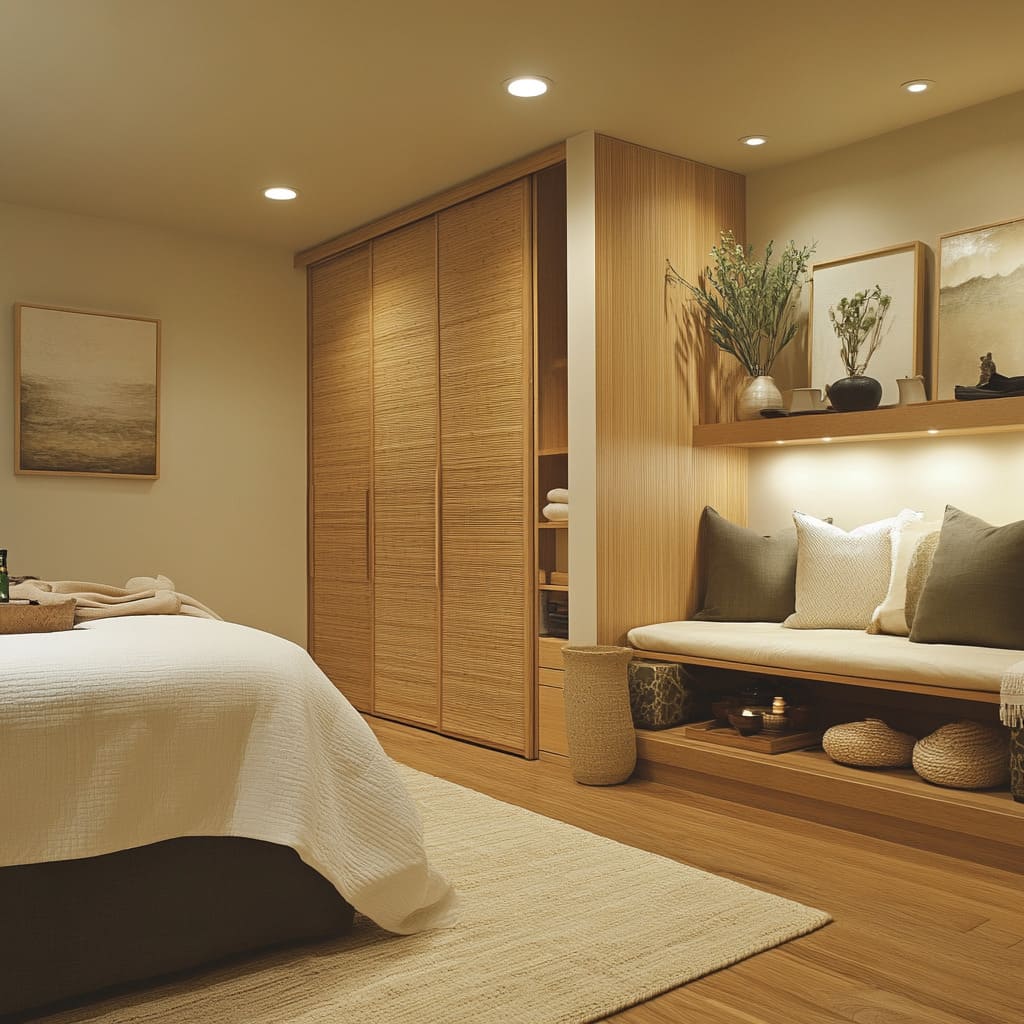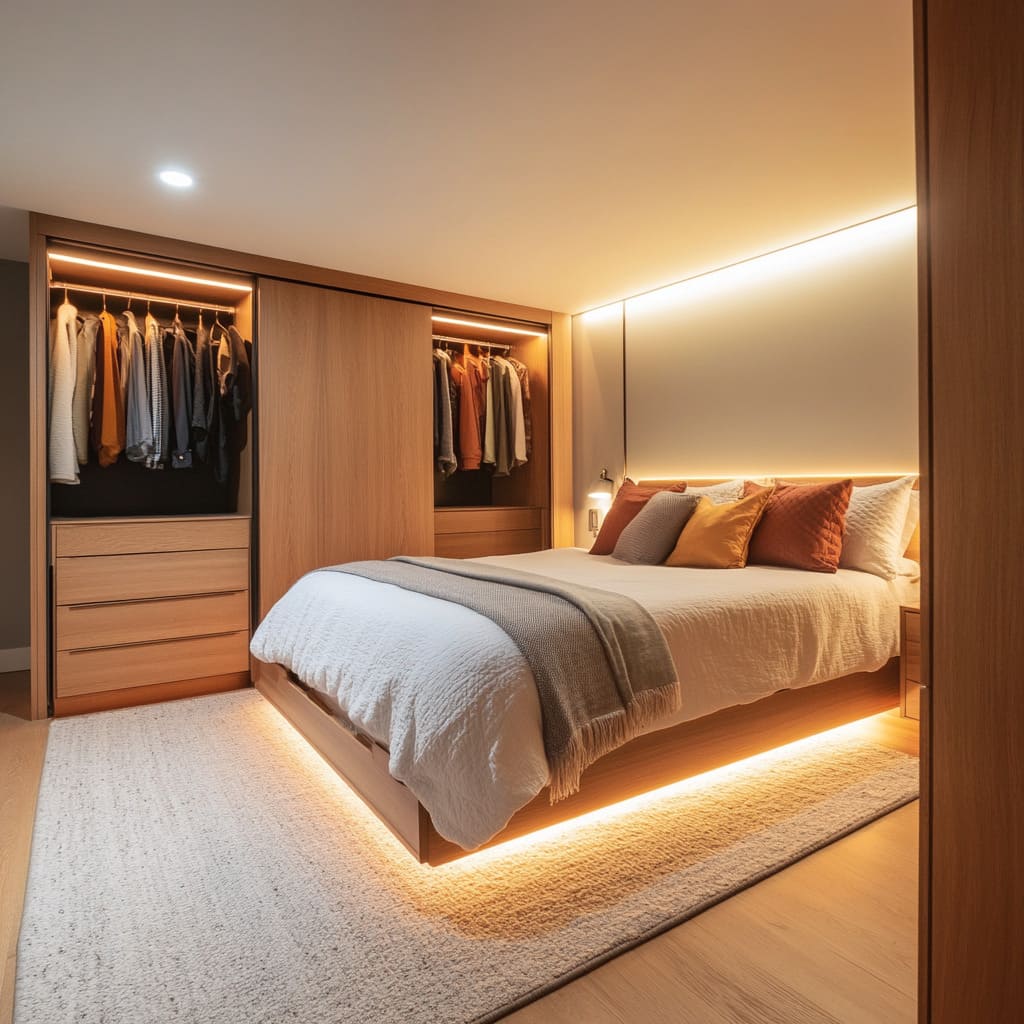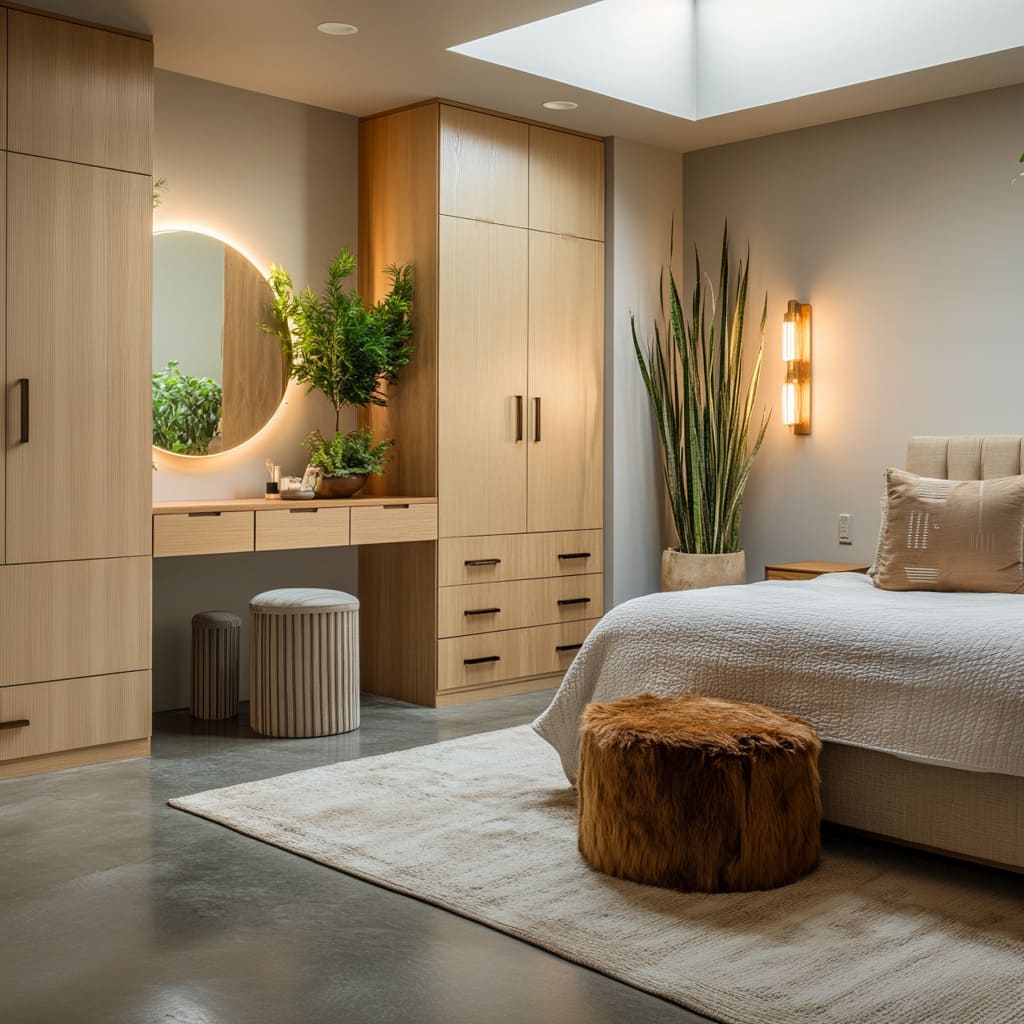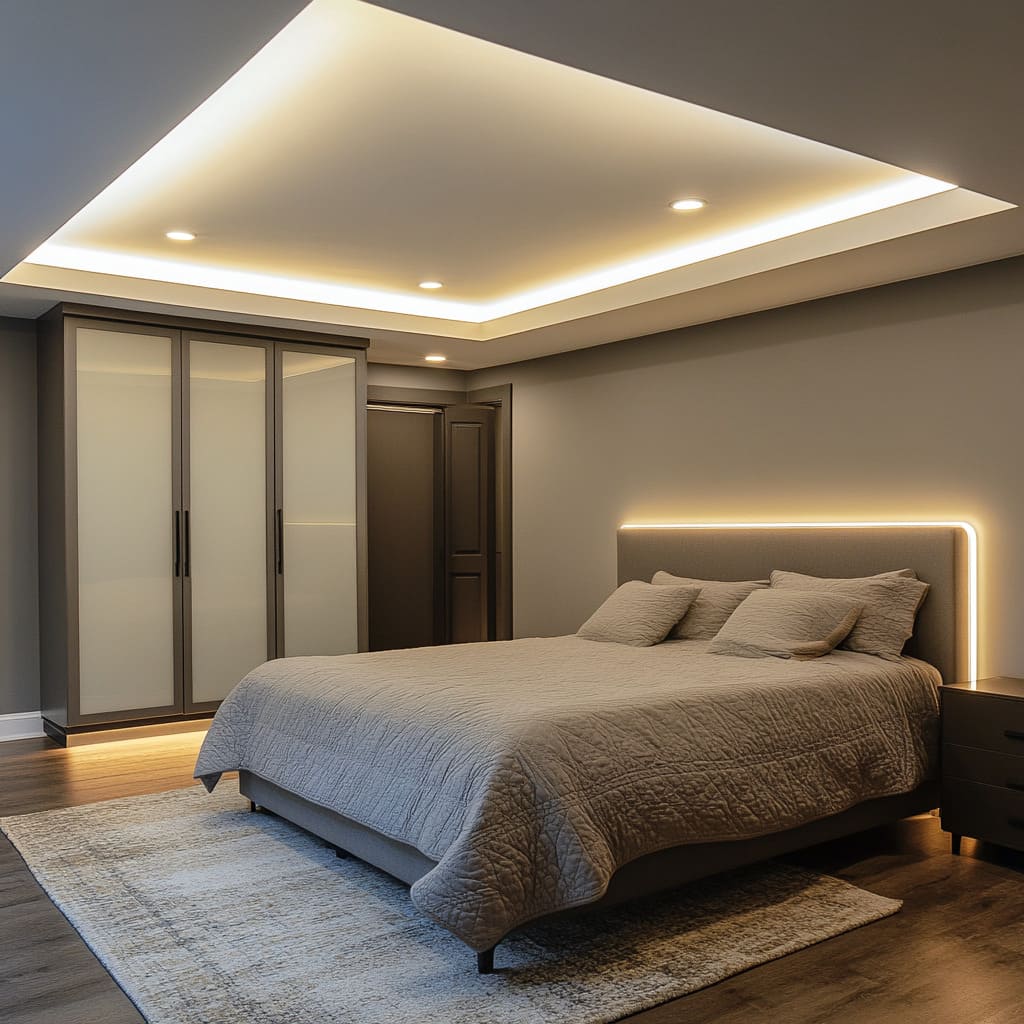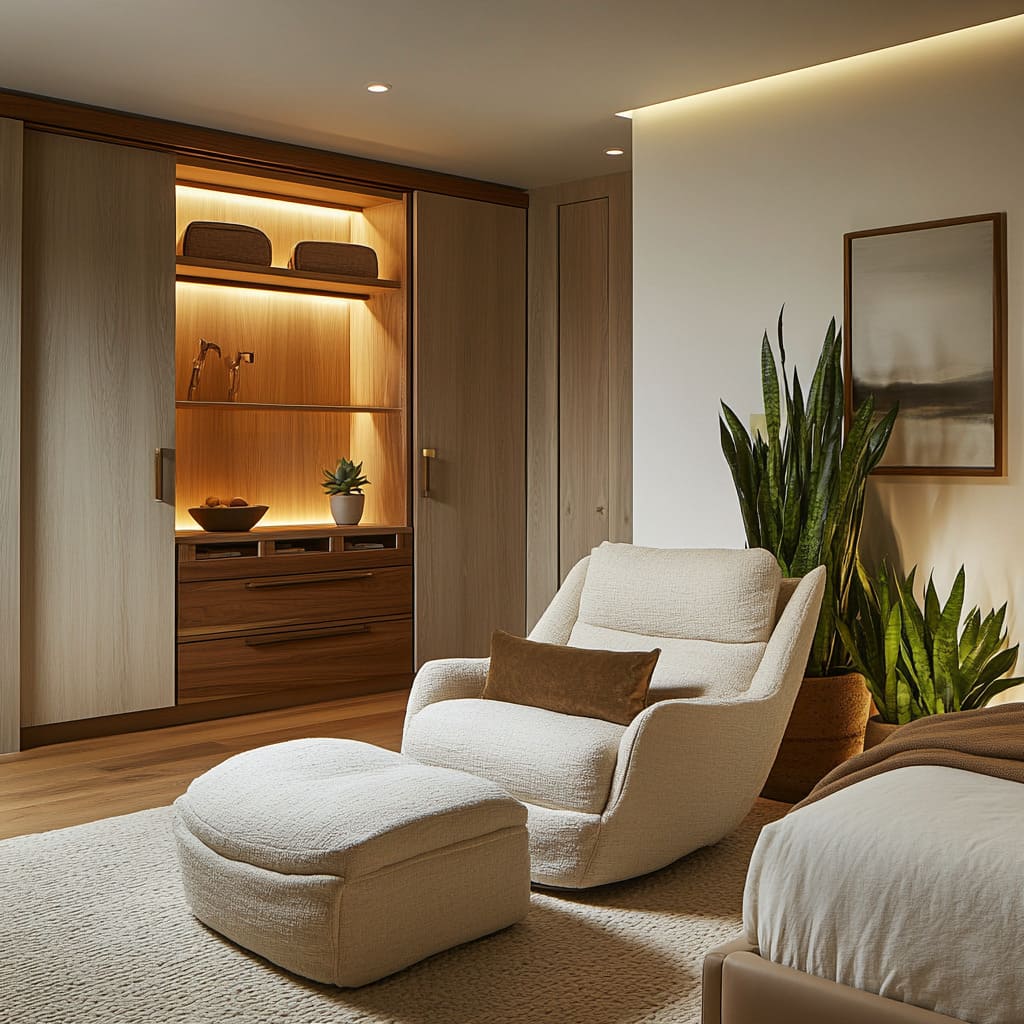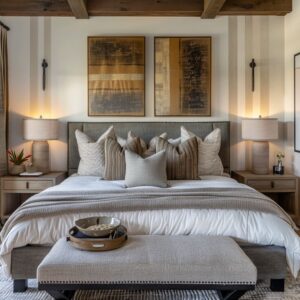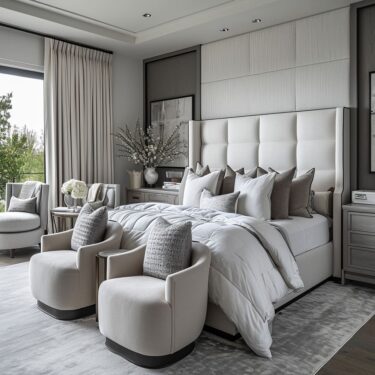Transforming a dim, windowless basement into a tranquil, spa-like retreat may seem like a challenge, but with the right design choices, it can become the most relaxing space in your home. Basements are often overlooked or relegated to storage or utility areas, yet they hold the potential to become a peaceful hideaway, free from the distractions of daily life.
The key lies in thoughtful design, focusing on simplicity, natural elements, and lighting that enhances the room’s comfort. By using a combination of minimalist design, neutral colors, and smart lighting, you can create a soothing atmosphere that feels anything but confined.
Natural materials, like wood and organic textiles, work beautifully in these spaces, giving the room a cozy warmth. Layered lighting can help you overcome the lack of natural light, ensuring the room feels inviting and calm.
In this article, we’ll walk through a range of basement bedroom design ideas to help you convert your space into the perfect spa-inspired retreat
We’ll cover essential design principles, including the basics of spa-like interiors, how to overcome common basement challenges, and why minimalism is key to a peaceful environment. Whether you’re adding a bedroom to a basement for the first time or thinking about turning your basement into a bedroom with a serene twist, this guide will provide you with all the inspiration you need to bring your vision to life
Understanding the Basics of a Spa-Inspired Bedroom
Defining Spa-Inspired Design
At the core of any spa-inspired bedroom is a focus on tranquility and simplicity. These designs are known for their use of natural materials, neutral color palettes, and soft, diffused lighting.
The goal is to create a space that helps you relax and unwind, free from visual clutter or overwhelming decor. Soft textures, calming earth tones, and a lack of excessive ornamentation are key.
Wood, stone, and woven elements work beautifully here, grounding the room in nature while providing a sense of warmth. The minimalist approach ensures that every element in the room has a purpose, contributing to an overall feeling of balance and ease
Lighting plays an equally important role in defining the mood. Unlike traditional bedrooms, where you might rely on windows for natural light, a basement bedroom requires a layered lighting approach.
Recessed ceiling lights, under-shelf lighting, and soft accent lamps can make the room feel brighter and more open. The right combination of lighting and textures creates a peaceful escape from the rest of the home
Challenges of Basement Bedrooms
Designing a bedroom in a basement comes with unique challenges. Basements often lack natural light, have lower ceilings, and can sometimes feel cooler or more enclosed than other parts of the house.
These factors can make the space feel less inviting if not addressed properly. The key to overcoming these obstacles lies in thoughtful design choices.
To compensate for the absence of windows, consider adding indirect lighting or using reflective surfaces to help bounce light around the room. Lower ceilings can be balanced out with low-profile furniture, such as platform beds, that emphasize horizontal lines rather than vertical space.
Additionally, choosing warm, natural materials—like wood cabinetry or soft, textured bedding—can help counteract any coldness in the room. The combination of these strategies allows you to transform a basement into a comfortable and welcoming space without feeling boxed in
The Importance of Minimalism in Spa-Inspired Design
Minimalism is key to achieving a calm, spa-like environment. The philosophy of “less is more” ensures that the space remains uncluttered and that every piece of furniture or decor serves a purpose.
In a basement, where space might be more limited, keeping things simple and streamlined prevents the room from feeling cramped. Clean lines, neutral tones, and functional furniture can help make the space feel much larger than it is
Minimalist design isn’t about starkness—it’s about making deliberate choices. By opting for quality over quantity, you can create a bedroom that feels open and breathable, allowing the space to work for you instead of against you.
A minimalistic approach to turning my basement into a bedroom will not only enhance the sense of calm but also ensure that the room feels light and airy, despite the lack of natural light
Furniture Selection
When it comes to furniture, simplicity and function are paramount. Low-profile beds, like the platform beds mentioned in the images, keep the room feeling open and less cluttered.
These beds work particularly well in basements, where ceiling heights may be lower than standard rooms. Sleek wardrobes and storage units with integrated lighting add both style and practicality, providing storage without taking up unnecessary space.
Floating furniture, such as bedside tables or shelving, can create the illusion of more space by keeping the floor clear. Built-in storage solutions further contribute to a streamlined look, ensuring that all clutter is tucked away while the room remains visually clean.
By carefully selecting furniture that complements the overall minimalist design, you can make the space feel more expansive and serene, regardless of the basement’s original layout
Choosing the Right Color Palette for Calm
Neutral Tones as a Foundation
When converting your basement into a tranquil bedroom, the foundation of the design starts with the right color palette. Neutral tones such as whites, beiges, soft creams, and light wood tones work beautifully to create an environment that feels open and peaceful.
These tones are not only visually soothing but also help make the room feel larger, a crucial factor in basement bedroom designs where space and light might be limited
A consistent palette of light colors has a calming effect, allowing the eyes to rest and the mind to relax. White or beige walls, paired with wooden accents, can instantly brighten the space, giving the illusion of a more expansive room.
Light-colored bedding, rugs, and furniture enhance this sense of openness, ensuring the room doesn’t feel cramped or closed off. The continuity of these shades across furniture and decor ensures the space feels cohesive rather than fragmented, making it easier to unwind.
For basements, these neutral tones also help counteract the lack of natural light. Darker hues might make the room feel more enclosed, whereas lighter colors reflect artificial light, amplifying brightness and creating a feeling of airiness
Accent Colors and Textures
While neutral tones form the base, subtle accents can bring warmth and character to the room. A few well-placed accents, such as rust-colored throw pillows or blankets, introduce contrast without overwhelming the space.
Soft throws or pillows in earthy hues like browns or muted oranges add depth and interest, breaking up the monotony of an all-neutral palette. The key is to ensure these accent colors are soft and in harmony with the neutral tones.
Too much contrast can disrupt the calming atmosphere you’re trying to achieve. Instead, opt for natural elements like a wooden side table, woven baskets, or a simple textured rug.
These textures enhance the spa-like feel without making the room appear cluttered. Layering these soft details creates a warm and inviting space while maintaining the room’s overall minimalist design
Lighting: The Secret to Brightening Up a Basement
Layered Lighting Approach
In basement bedrooms, lighting is your best friend. Without natural light pouring in through windows, you’ll need to get creative with how you illuminate the room.
A well-planned layered lighting approach can work wonders in making the space feel bright and inviting. This technique involves using different light sources at varying levels to create a balanced, warm glow that mimics natural light
Start with recessed ceiling lights to provide the room’s general lighting. These small, unobtrusive fixtures offer plenty of brightness without drawing attention away from the design elements.
Complement them with soft ambient lighting like LED strips hidden in the ceiling or around furniture. This indirect lighting technique softens the overall illumination, preventing harsh shadows while making the room feel warm and cozy
Highlighting Features with Light
Incorporating lighting into specific design features can add both function and style. Built-in shelving with integrated lighting can make storage spaces or decorative displays stand out while providing extra light.
Highlighting slatted wood panels or cabinet details with hidden lighting can also bring out textures and architectural details, adding to the room’s overall ambiance. Consider using wall-mounted lamps next to the bed or above a reading nook, as seen in many basement bedroom decor ideas.
These can serve as task lighting while also contributing to the room’s mood. The strategic placement of soft lighting can transform even the darkest corners of your basement into a relaxing haven
Choosing Warm vs. Cool Lighting
When selecting light fixtures, it’s essential to consider the color temperature of your bulbs.
Warm, diffused lighting works best for creating a soothing and comfortable space. Harsh, cool-toned lights can make the room feel sterile and less inviting.
Opt for bulbs with a soft, warm hue to evoke a more relaxing atmosphere. The soft glow from these lights will not only brighten up your basement bedroom but also enhance the comfort of the space
Natural Materials and Textures: Bringing the Outdoors In
Wood and Woven Elements
Incorporating natural materials is an easy way to make your basement feel less like an underground space and more like a cozy retreat. Wooden furniture, whether it’s a bed frame, shelves, or cabinetry, can bring a sense of warmth and balance to the room.
Light wood tones, such as oak or pine, reflect light and maintain the airy feel you want in a basement bedroom. Woven textures, such as wicker baskets or rattan pendant lights, add another layer of natural beauty to the room.
These elements are particularly effective in creating a relaxed, spa-like atmosphere because they evoke feelings of nature and simplicity. The combination of wood and woven accents can subtly break up the clean lines of a minimalist room, making it feel more inviting without adding visual clutter
Adding Greenery
A great way to further bring nature indoors is by incorporating plants. In a basement bedroom, choosing the right kind of greenery is key.
Snake plants, ferns, or succulents are excellent options, as they thrive in low-light environments and require minimal care. Not only do plants improve air quality, but they also provide a refreshing contrast to the neutral tones of the room.
The vibrant green of the plants against the soft hues of the room adds a subtle pop of color without overwhelming the space. A few well-placed potted plants on open shelves or near the bed can instantly make the room feel more alive.
Greenery is an essential element of many basement bedroom decor ideas, helping to soften the modern, minimalist aesthetic while reinforcing the calming, nature-inspired vibe
Furniture and Layout: Maximizing Comfort and Space
Low-Profile Beds and Sleek Storage Solutions
When you’re working with limited space in a basement bedroom, choosing the right furniture is essential to making the room feel comfortable without being cramped. Low-profile beds, like platform beds, are a fantastic choice for smaller spaces.
These beds sit close to the floor, creating a sleek, modern look that doesn’t overwhelm the room. Additionally, their minimalist design helps emphasize the horizontal lines of the space, making it feel more open, even in a basement with lower ceilings
Built-in cabinetry is another clever way to maximize storage without cluttering the space. These custom solutions can be seamlessly integrated into the walls, providing ample room for storing clothes, linens, and other bedroom essentials without taking up valuable floor space.
The smooth, streamlined appearance of built-in cabinets ensures that the room maintains its clean, uncluttered aesthetic, which is particularly important in small basement bedroom design ideas
Incorporating Cozy Seating Areas
A bedroom should be more than just a place to sleep—it should also offer spaces to relax and unwind. Incorporating a small reading nook with a cozy armchair and ottoman is a great way to achieve this.
A well-placed armchair, paired with a soft ottoman, can transform an unused corner into a relaxing retreat within your basement master bedroom suite ideas. The key is to choose furniture that is proportional to the room’s size.
Opt for sleek, comfortable pieces that won’t dominate the space. A minimalist armchair in a neutral tone, paired with a plush throw or a soft pillow, can create the perfect spot for quiet reading or unwinding after a long day.
By keeping the furniture simple and appropriately scaled, you can introduce function without overcrowding the room
Creating a Spa-Like Ambience Through Texture and Soft Furnishings
Layering Textiles for Comfort
The power of textiles in transforming a room’s feel cannot be underestimated. To create a relaxing, spa-like atmosphere, layering soft, luxurious fabrics is essential.
Begin with high-quality bedding—soft, quilted linens in neutral shades like white, cream, or beige. Add a plush throw at the foot of the bed, perhaps in a cozy knit or with a soft fringe.
These small touches bring depth and warmth to the room, inviting you to relax and unwind
Throw pillows in varying sizes and textures are another key element, adding both comfort and style to the space. Using a mix of velvet, cotton, or faux fur pillows can enhance the tactile experience, making the room feel more luxurious.
Plush area rugs also play a vital role in adding warmth, especially when you’re dealing with hard flooring like concrete or wood in a basement. By layering these soft furnishings, you can achieve that spa-like feel, perfect for any basement bedroom ideas
Using Rugs to Define Spaces
Rugs are not just practical; they also serve to define areas within the room. A large area rug placed under the bed can anchor the room, helping to ground the space and make it feel more cohesive.
Opt for soft, neutral-toned rugs with subtle textures to complement the overall minimalist design. In smaller spaces, rugs can also help create visual separation between different functions of the room, such as a sleeping area and a reading nook.
The warmth and texture a rug adds is particularly effective in a basement room, where flooring can often feel cold. In addition, it provides a tactile contrast to harder surfaces, enhancing the room’s comfort and making it feel more intimate
Seamless Built-In Storage
For basement rooms, where floor space might be at a premium, built-in storage solutions offer a perfect blend of practicality and aesthetics. Integrated cabinetry or open shelving can provide storage for clothes, books, and other essentials without taking up too much room.
This approach not only helps reduce clutter but also maintains the clean, minimalist aesthetic you want in a relaxing space. Incorporating sleek, floor-to-ceiling cabinets along one wall can provide all the storage you need while keeping the rest of the room open and uncluttered.
In many basement bedroom ideas, especially where space is tight, the choice of storage becomes critical to the room’s overall layout. Seamless, built-in options ensure that the room stays tidy and functional, with everything neatly hidden away
Incorporating Decorative Storage Solutions
Decorative storage solutions can be both practical and stylish, adding charm without sacrificing functionality. Woven baskets, neatly placed on open shelves, provide storage for extra blankets, pillows, or even reading materials while adding texture and warmth to the room.
Soft, folded textiles on display shelves can also serve as decor, enhancing the room’s aesthetic while doubling as accessible storage
These storage ideas work particularly well in basement room decor ideas, where storage must be carefully planned to avoid overwhelming the space. By blending function and style, you can ensure that your bedroom feels both organized and welcoming, striking the perfect balance between form and function
Final Touches: Art and Personal Accents
Curating a Minimalist Display
When it comes to completing your spa-inspired basement bedroom, it’s the small, thoughtful details that bring personality to the space without overwhelming the calm atmosphere. Minimalist decor doesn’t mean barren or devoid of character; rather, it’s about choosing simple yet meaningful accents that enhance the room’s aesthetic
A great example is abstract artwork. Opt for pieces that use soft, neutral tones, or subtle textures, which will complement the overall design without being too loud.
A single large piece above the bed or a few smaller framed prints on a floating shelf can make a quiet, elegant statement. Similarly, ceramic vases in natural finishes—whether matte or with a slight sheen—add a sculptural element to the room.
These objects should have organic shapes, offering a hint of artistic flair without interrupting the room’s harmony. Another idea is to select pieces that resonate with you personally, but which remain simple and uncluttered in form.
A hand-thrown pottery bowl, a textured wall hanging, or a woven basket can add charm while still fitting into the minimalist design. By focusing on items that are subtle in form and color, you can add character without disrupting the room’s peaceful nature
Keeping Decor Subtle
The key to maintaining the tranquility of your basement bedroom is ensuring that decor choices don’t lead to clutter. Less truly is more in this case.
While it may be tempting to display a variety of keepsakes, resist the urge to fill every surface. Instead, aim for a handful of carefully chosen items that both serve a functional and aesthetic purpose.
For example, a small shelf above your reading nook might feature a few favorite books paired with a small potted plant or a simple framed photo. Each item should be intentional and complement the minimalist design of the room.
The overall goal is to avoid visual chaos, ensuring that each decorative piece serves a purpose—whether it’s bringing in natural textures, a personal touch, or a bit of greenery. By doing this, your room remains cohesive and peaceful, a hallmark of successful basement master bedroom ideas
Overcoming Common Basement Bedroom Challenges
Dealing with Low Ceilings
Basements often come with lower ceilings, which can make the space feel smaller and more confined than it actually is. One simple solution is to incorporate recessed lighting or hidden strip lighting along the perimeter of the ceiling.
These lighting options take up less visual space while providing the room with an even, ambient glow. The effect draws the eye upwards, creating the illusion of more height.
Another tip is to select low-profile furniture, such as platform beds and shorter shelving units. These pieces emphasize horizontal lines, which help balance out the low ceiling by keeping the focus at a lower level.
This trick creates a sense of openness and prevents the room from feeling boxed in, which is a common concern when turning a basement into a bedroom
Combatting the Lack of Natural Light
The absence of windows or limited natural light is a frequent challenge in basement bedrooms, but it can be managed with the right lighting strategy. As discussed earlier, a layered lighting approach that includes recessed lights, wall sconces, and floor lamps can help brighten the space without creating harsh shadows.
Soft, diffused lighting is the way to go, especially when trying to replicate the feel of daylight. In addition to lighting, mirrors are another great tool for brightening up a basement bedroom.
Strategically placing mirrors across from light sources helps bounce light around the room, giving it more depth and enhancing the feeling of openness. If you prefer reflective surfaces, choosing furniture with glossy or glass finishes can also have a similar effect, amplifying the light and creating a more welcoming environment
Conclusion
Creating a spa-inspired bedroom in your basement requires thoughtful design, but the payoff is a calming retreat that’s perfect for rest and relaxation. By embracing minimalism, using natural materials, and incorporating soft, layered lighting, you can turn even the most confined basement space into an inviting room.
Whether you’re working with basement bedroom ideas on a budget or embarking on a full remodel basement into master bedroom project, the design principles of simplicity, balance, and subtle personal touches will transform your space
In the end, your basement bedroom should feel like a personal oasis—peaceful, functional, and uniquely yours. With these strategies, you’ll find that transforming a basement into a bedroom is not just about overcoming challenges, but about creating a space that enhances your comfort and well-being.

